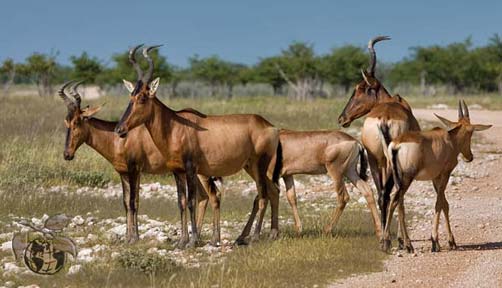. Alcelaphus buselaphus tora
Common name:
English - Tora Hartebeest
Status
The Tora hartebeest was listed under the IUCN Red List of Threatened Species as endangered throughout its range on July 27, 1979.
Description
The hartebeest, like many antelope, is primarily diurnal, grazing in the early morning and late afternoon, and resting in a shaded area during the hottest part of the day. During feeding periods, a sentry watches for potential sources of danger, and can often be seen standing on a termite mound in order to increase the range of visibility. When fleeing, the herd runs in single file, and can reach speeds of up to 80 kmph / 48 mph. At 3-4 years of age, males attempt to hold a territory. Marked with dung piles, these defended regions average 31 hectares in area, and are generally taken over by another male after 4-5 years. Females and males alike are generally non-aggressive, although both sexes will fight vigorously in defense of their offspring or territory. Population densities average 1.4 animals per square kilometer.
Habitat
Hartebeests live mainly in grasslands and savannas. They tend to forage for food in the open. They prefer to stay in one area, but will move locations if conditions become severe, as in the case of a drought.
Distribution
Native:
Angola; Benin; Botswana; Burkina Faso; Cameroon; Central African Republic; Chad; Congo, The Democratic Republic of the; Côte d'Ivoire; Eritrea; Ethiopia; Ghana; Guinea; Guinea-Bissau; Kenya; Mali; Namibia; Niger; Nigeria; Senegal; South Africa; Sudan; Swaziland; Tanzania, United Republic of; Togo; Uganda; Zimbabwe
Regionally extinct:
Algeria; Egypt; Lesotho; Libyan Arab Jamahiriya; Morocco; Somalia; Tunisia
Possibly extinct regionally:
Gambia
Population
Hartebeests live in herds of up to 300, made up of smaller groups that are separated into young males; females and their young; territorial males and non-territorial males. When a predator approaches the herd, one or more hartebeests give off an alarm snort and they gallop away in single file at speeds of up to 50 miles (80 km) per hour.
Threats
Although a prolific breeder and even a dominant species in some areas, the hartebeest has probably suffered the greatest reduction in range of all African ruminants. This is both because it is easily hunted (being relatively sedentary), and because its diet is almost equivalent to that of cattle—it must compete for food resources.
Conservation Efforts
Hartebeests were once the widest-ranging antelopes in Africa, but hunting, urban development and competition with domestic herds of cattle have limited their range and numbers. They are now found only in select portions of African countries such as Kenya, Senegal, Ethiopia, Zimbabwe, Botswana, Namibia and Tanzania. A subspecies, the bubal hartebeest that once ranged through Algeria, Egypt, Libya, Morocco and Tunisia became extinct in the 1920s. Although the common hartebeest is listed as Lower Risk, Conservation Dependent by the IUCN, two subspecies (Swayne’s hartebeest and Tora hartebeest) are listed as Endangered, while the Bubal hartebeest is Extinct. Several national parks and reserves in Africa are now home to hartebeests.
